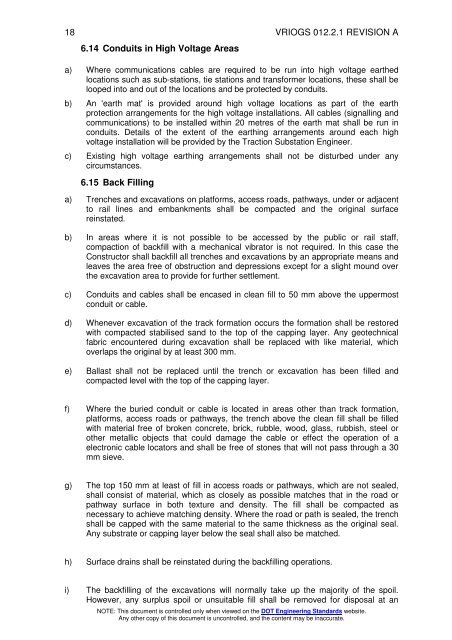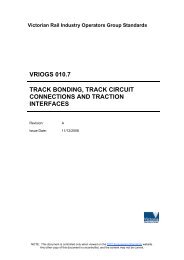VRIOGS 012.2.1 - Public Transport Victoria
VRIOGS 012.2.1 - Public Transport Victoria
VRIOGS 012.2.1 - Public Transport Victoria
Create successful ePaper yourself
Turn your PDF publications into a flip-book with our unique Google optimized e-Paper software.
18 <strong>VRIOGS</strong> <strong>012.2.1</strong> REVISION A<br />
6.14 Conduits in High Voltage Areas<br />
a) Where communications cables are required to be run into high voltage earthed<br />
locations such as sub-stations, tie stations and transformer locations, these shall be<br />
looped into and out of the locations and be protected by conduits.<br />
b) An 'earth mat' is provided around high voltage locations as part of the earth<br />
protection arrangements for the high voltage installations. All cables (signalling and<br />
communications) to be installed within 20 metres of the earth mat shall be run in<br />
conduits. Details of the extent of the earthing arrangements around each high<br />
voltage installation will be provided by the Traction Substation Engineer.<br />
c) Existing high voltage earthing arrangements shall not be disturbed under any<br />
circumstances.<br />
6.15 Back Filling<br />
a) Trenches and excavations on platforms, access roads, pathways, under or adjacent<br />
to rail lines and embankments shall be compacted and the original surface<br />
reinstated.<br />
b) In areas where it is not possible to be accessed by the public or rail staff,<br />
compaction of backfill with a mechanical vibrator is not required. In this case the<br />
Constructor shall backfill all trenches and excavations by an appropriate means and<br />
leaves the area free of obstruction and depressions except for a slight mound over<br />
the excavation area to provide for further settlement.<br />
c) Conduits and cables shall be encased in clean fill to 50 mm above the uppermost<br />
conduit or cable.<br />
d) Whenever excavation of the track formation occurs the formation shall be restored<br />
with compacted stabilised sand to the top of the capping layer. Any geotechnical<br />
fabric encountered during excavation shall be replaced with like material, which<br />
overlaps the original by at least 300 mm.<br />
e) Ballast shall not be replaced until the trench or excavation has been filled and<br />
compacted level with the top of the capping layer.<br />
f) Where the buried conduit or cable is located in areas other than track formation,<br />
platforms, access roads or pathways, the trench above the clean fill shall be filled<br />
with material free of broken concrete, brick, rubble, wood, glass, rubbish, steel or<br />
other metallic objects that could damage the cable or effect the operation of a<br />
electronic cable locators and shall be free of stones that will not pass through a 30<br />
mm sieve.<br />
g) The top 150 mm at least of fill in access roads or pathways, which are not sealed,<br />
shall consist of material, which as closely as possible matches that in the road or<br />
pathway surface in both texture and density. The fill shall be compacted as<br />
necessary to achieve matching density. Where the road or path is sealed, the trench<br />
shall be capped with the same material to the same thickness as the original seal.<br />
Any substrate or capping layer below the seal shall also be matched.<br />
h) Surface drains shall be reinstated during the backfilling operations.<br />
i) The backfilling of the excavations will normally take up the majority of the spoil.<br />
However, any surplus spoil or unsuitable fill shall be removed for disposal at an<br />
NOTE: This document is controlled only when viewed on the DOT Engineering Standards website.<br />
Any other copy of this document is uncontrolled, and the content may be inaccurate.

















